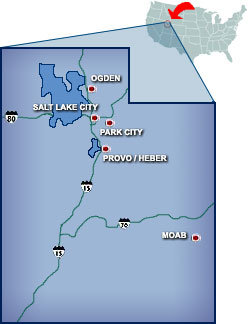 |
About
the State of Utah
Utah, a name that
comes from the Native American Ute tribe meaning “people
of the mountains”, has a population of just over 2
million people. Today, excellent recreational opportunities
along with a good business environment maintain Utah’s
rich heritage.
 Indian
tribes included the Ute, Southern Paiute, Navajo,
Gosiute, Northern and Eastern Shoshone who lived similar
lifestyles by hunting, fishing and gathering wild
plant foods. Early Mexicans and Spaniards were the
first non-Indians to visit Utah to trap beaver and
otter for fur. But it was the small group of pioneers
led by Brigham Young in 1846, who would make the greatest
mark on the future state of Utah. Indian
tribes included the Ute, Southern Paiute, Navajo,
Gosiute, Northern and Eastern Shoshone who lived similar
lifestyles by hunting, fishing and gathering wild
plant foods. Early Mexicans and Spaniards were the
first non-Indians to visit Utah to trap beaver and
otter for fur. But it was the small group of pioneers
led by Brigham Young in 1846, who would make the greatest
mark on the future state of Utah.
Following the establishment
of Bountiful, Utah, Young and his followers expanded
to 500 settlements between 1847 and 1900. Hunting,
fishing and agriculture sustained the small communities
until the coming of the railroad in 1869 changed the
West forever. Mining became the major economic resource
in the late 1800’s and between 1860 and 1900 the population
of Utah jumped from 40,000 to 200,000 people. Utah
was accepted into the Union in 1896. Utah’s economy
expanded to include recreation and high tech industries
in the late 1900’s.
At the heart of the development
of Utah has been the faith that first brought the
pioneers to the area. The Church of the Latter Day
Saints (Mormons) has remained the most powerful decision-making
body in the area and anyone visiting Salt Lake City
will enjoy the beauty of the famous Mormon Temple
and hopefully, the voices of the Mormon Tabernacle
Choir.
The 2002 Winter Olympics
will feature events in Salt Lake City, Ogden and the
surrounding ski resorts of Park City, Deer Valley
and Snowbasin Ski Area.
Facts, figures and maps of Salt
Lake City and Utah.
History
of Salt Lake City and Utah
|
Virtual
Tours
Don’t just read about Salt Lake City and Utah, see it!
Visit the city and explore the sites of the Olympic
Games on these virtual tour sites.
Weather
What’s the weather like in Salt Lake City?
Search these weather sites for competition
conditions. |
|
|
 |


